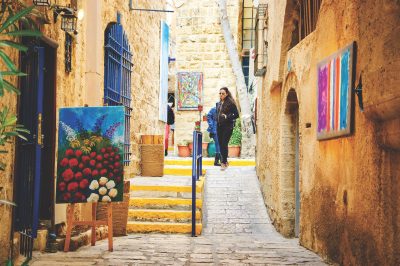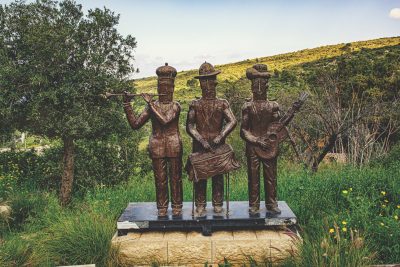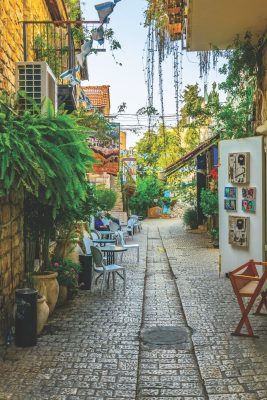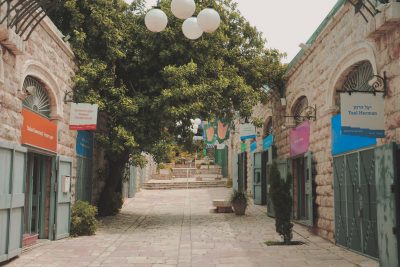×


We have detected your country as:
Please click here to go to the USA website or select another country from the dropdown list.
by: Nathan Williams, Director of Marketing and Communications
Many of us are familiar with the names of neighborhoods that originated from Christians establishing religious colonies in Israel. The American and German colonies are famous, among many others. Perhaps less well known is that scattered throughout Israel are another kind of colony: artistic colonies. An artists’ colony is a community where artists work, create and even live together, drawing inspiration from their surroundings. Each of these artist communities has its own unique atmosphere where eccentricity is wholly embraced.
 A Utopian Dream
A Utopian DreamThe founder and head of the Bezalel School of Arts and Crafts, Boris Schatz, envisioned the creation of a utopia for artists in Israel. Bringing his vision to life through the Ben Shemen Artists’ Colony in 1914, Schatz wanted to lure different artists to leave tumultuous city life for communal living, where they could find mutual inspiration and creativity. Comprised mostly of Jewish goldsmiths from Yemen, the Ben Shemen Artists’ Colony was the realization of Schatz’s dream. Unfortunately, the first artist colony was short-lived, but Schatz’s vision lived on. Some 40 years after the failure of the first artists’ colony, artist and architect Marcel Janco reinvigorated Schatz’s vision in the 1950s with the establishment of the Old Jaffa and Ein Hod artist colonies. During the same period, a group of Israeli artists started the Tzfat Artists’ Quarter in northern Israel. Each of these colonies and their artists still flourish to this day.
Known in the Bible as Joppa, the departure point of Jonah to Tarshish when fleeing the call of the Lord to go to Nineveh, Jaffa is one of Israel’s oldest ancient cities. Perched on a hilltop with a natural harbor, Jaffa has been a strategic prize for thousands of years. Today, it is still an active fishing port but also functions as a tourist hub with restaurants, boutique hotels and event halls. The winding alleyways, reminiscent of Jerusalem’s Old City, are lined with historic stone buildings that host art galleries and bespoke artisans.
CeMMent Design Studio is the brainchild of Marit Meisler, a seasoned artist who was born and raised in Jaffa. Using concrete as her main creative medium, Meisler creates contemporary household objects and modern Judaica.
At the New Gate on the Jaffa Old City walls is the fashion house of Maskit, founded in 1954 by Ruth Dayan, the widow of the former chief of staff and Israeli Defense Minister Moshe Dayan (famous for his role in the reunification of Jerusalem in 1967). Maskit draws inspiration for its contemporary clothing line from traditional embroidery techniques and the landscapes and colors of Israel. Esteemed as a national treasure, the House of Maskit is a symbol of Israeli culture and art.
 The second colony established by Marcel Janco was in Ein Hod, which sits on a hill overlooking the Mediterranean coast. While Old Jaffa and Tzfat have become production centers for popular Jewish art, Ein Hod has maintained Schatz’s original vision as a true artist’s utopia, where residents can create and thrive in a cooperative structure. In honor of the visionary who through persistence and dedication launched this community, the Janco–Dada Museum features the works of the founder, Marcel Janco. According to Ein Hod’s website, communal life is managed by a general assembly and an executive committee, who also decide on new artists who take up residence in the colony. What is unique about Ein Hod is that most of the art studios and galleries are situated in the artists’ homes, giving visitors a unique glimpse into the lives and creative processes of the creators. This what makes Ein Hod so special. How often can you speak to an artist in their own home about a piece of work they have just created? From painters, potters and sculptors to writers, poets and playwrights, Ein Hod is a microcosm of Israel’s artistic talents.
The second colony established by Marcel Janco was in Ein Hod, which sits on a hill overlooking the Mediterranean coast. While Old Jaffa and Tzfat have become production centers for popular Jewish art, Ein Hod has maintained Schatz’s original vision as a true artist’s utopia, where residents can create and thrive in a cooperative structure. In honor of the visionary who through persistence and dedication launched this community, the Janco–Dada Museum features the works of the founder, Marcel Janco. According to Ein Hod’s website, communal life is managed by a general assembly and an executive committee, who also decide on new artists who take up residence in the colony. What is unique about Ein Hod is that most of the art studios and galleries are situated in the artists’ homes, giving visitors a unique glimpse into the lives and creative processes of the creators. This what makes Ein Hod so special. How often can you speak to an artist in their own home about a piece of work they have just created? From painters, potters and sculptors to writers, poets and playwrights, Ein Hod is a microcosm of Israel’s artistic talents.
 Tzfat
TzfatPerhaps most well known as the “City of Kabbalah” (Judaism’s mystical tradition), Tzfat also played an important role in developing some of Israel’s most renowned artists and helping them achieve international recognition. Israeli painter Yitzhak Frenkel moved to Tzfat in 1934—14 years before it was officially established as an artist colony—and was inspired by the ancient synagogues, quaint alleyways and the surrounding beauty of the mountains. Frenkel was inspired by the land of Israel after completing an artistic journey across the country, painting Israel from Tzfat to the Galilee and Jerusalem, then Tel Aviv and the Negev. North to south, Frenkel drew inspiration from the varied landscapes of the Promised Land. Tzfat’s Artists’ Quarter, dubbed the “Bohemian Center of Israel,” is where casual art enthusiasts and art aficionados are welcome to appreciate the world of art, beauty and eccentricity.
 During a time of great change, the Hutzot HaYotzer artist colony was established in Jerusalem. Following the Six Day War and the reunification of the city in 1967, there was a vast swath of no-man’s land between the Old City walls and the neighborhood of Yemin Moshe. Then Mayor of Jerusalem Teddy Kollek decided to rebuild the ruins at the northern end of the Gehenna valley and thus created a bustling arts and crafts center.
During a time of great change, the Hutzot HaYotzer artist colony was established in Jerusalem. Following the Six Day War and the reunification of the city in 1967, there was a vast swath of no-man’s land between the Old City walls and the neighborhood of Yemin Moshe. Then Mayor of Jerusalem Teddy Kollek decided to rebuild the ruins at the northern end of the Gehenna valley and thus created a bustling arts and crafts center.
The website for Hutzot HaYotzer invites visitors to come and meet “the extraordinary cast of characters at the Artists’ Lane that will inspire your Israel journey.” The colony features varied artistic crafts, from silversmiths and sculptors to calligraphy and fiber arts. Workshops and galleries are open to visitors at no cost, and the artists are available in person to meet and welcome visitors.
One cannot help but feel inspired traveling across a country steeped in ancient history. From the barren beauty of the Negev desert to the majestic mountains in the north, the landscapes of Israel are dramatic and inspiring. On your next trip to the Promised Land, be sure to stop in at one, or all, of Israel’s artist colonies. These are wonderful places to visit and journey into Israel’s creative and expressive side.
Photo Credit: Click on Photo To See Photo Credit
All logos and trademarks in this site are property of their respective owner. All other materials are property of Bridges for Peace. Copyright © 2025.
Website Site Design by J-Town Internet Services Ltd. - Based in Jerusalem and Serving the World.